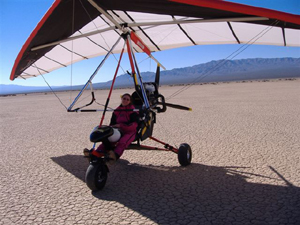Propellers for Ultralight Trikes
Ultralight Trikes are the granddaddies of ultralight flying. It kind of went like this. The “rogallo wing” was the early favorite for hang glider enthusiasts that hurled themselves off the slopes and cliffs of the California coast. Its structure consists of a center or keel tube attached to two swept leading edge tubes. A single surface of sailcloth covers the few ribs it sports. The leading edge tubes are kept in place with a kingpost on top and a simple understructure that also supports the pilot in a sling. Control was and still is by weight shift for both pitch and roll. The pilot can be prone in flight or he can sit in a seat.
As it was with the evolution of all early ultralight gliders, trikes have grown up and now can sport engines, instruments, enclosures, two seats and all the bells and whistles of its flying cousins.
Because of their wing simplicity, they can be folded and easily transported and stored. They have very short take off and landing characteristics and can fly in somewhat turbulent conditions. Their popularity continues to grow, because they are relatively low cost, easy to fly and portable.
Fly Hard Trikes, the Sabre, and NorthWing Trikes have used the Ultra-Prop as standard equipment and many other types have found the advantages of the smooth and durable Ultra-Prop. It is an ideal replacement for many of the wood props used by the original equipment manufacturers to reduce cost. Larger trike models have discovered the benefits of using the Brolga with ease of assembly, perfect pitch, excellent performance and smoothness. For a long time, the Australian Airborne Trikes used the Brolga exclusively. Now the Ultra-Prop II can be used on many of the new generation Trikes.
Contact us for our recommendations for other applications.



